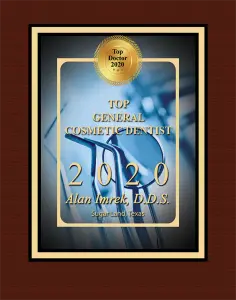Root Canal
Ready to Change Your Smile? Get that beautiful, bright look you have always wanted from a safe and professional environment. Call Sugar Land Office Phone Number (281) 494-3368 to make an appointment.
FIRST DENTAL: ROOT CANAL TREATMENT
Your Sugar Land TX dentist may recommend root canal treatment to repair a badly damaged or infected tooth. A root canal can relieve dental pain and even save your tooth.
Dentists save millions of teeth each year through root canal treatment, also known as endodontic treatment. Endodontics is an area of dentistry that focuses on the treatment of dental pulp, which is the tissue at the center of a tooth. The pulp contains nerves, blood vessels, and connective tissue that support the tooth during its development.
The root canal is actually a part of a tooth that sits beneath the white layer of tooth enamel and the hard layer of dentin. The dental pulp is inside the root canal.
The primary job of pulp is to create the tooth enamel and dentin during development of the tooth. Pulp becomes less important after the tooth has fully developed. In fact, a fully mature tooth can survive without the pulp because it gains its nourishment from the tissues surrounding it.
A root canal becomes necessary when the soft tissues of the pulp become infected or inflamed from tooth decay, a cracked tooth, or repeated dental procedures on a tooth. Left untreated, inflamed or infected pulp tissue can cause an abscess, which is a buildup of puss that forms inside the teeth or gums. The infection can spread to other parts of the body. In some cases, the spread of infection can even be life-threatening.
Without treatment, the tooth can become loose and in need of extraction. Endodontics saves the tooth and stops the pain by removing the infected or inflamed pulp.
You may need a root canal if you have one or more of the following symptoms:
- Severe pain while biting or chewing
- Bumps or pimples on the gum
- A cracked or chipped tooth
- Sensitivity to hot or cold that continues even after exposure to the heat or cold stops
- Tender or swollen gums
- Deep tooth decay, sometimes indicated by darkening of the gums
THE ROOT CANAL TREATMENT PROCEDURE
Your dentist can perform endodontic treatment in one or two steps. Teeth that have curved canals, multiple canals, or large infections may need two or more appointments.
The procedure starts with a thorough examination and x-rays of the affected tooth. Next, the endodontist administers a local anesthetic to numb the treatment area.
The next step is to make an opening in the crown, which is the part of the tooth that appears above the gum line. The dentist inserts small instruments through the access point in the crown to clean the infected and inflamed tissue from the pulp chamber and root canal. The endodontist then cleans and decontaminates the inside of the tooth and shapes the space. Finally, the dentist fills the treated space with a biocompatible material and seals it with a temporary filling. The last step is to place a crown on the tooth to protect it and restore function.
A root canal does not “kill” the tooth, and the tooth will be fully functional after the root canal. Since the nerve is gone, though, the patient should not feel any pain.
Once restored, the treated tooth should last as long as other natural teeth, although the tooth may be more fragile than before. Good oral hygiene that includes brushing twice a day, daily flossing, and regular checkups and cleanings keeps your root canal intact. In some cases, a treated tooth may develop pain or disease months or even years after treatment; redoing the endodontic procedure can help save the tooth.
Many people mistakenly believe that root canal treatment is painful when, in fact, orthodontics is actually a pain-relieving treatment.
The cost of root canal therapy varies, depending largely on the severity of inflammation and infections. In most cases, though, endodontics cost less than have a tooth removed and replaced with a crown or a bridge.
For more information about root canals, contact First Dental Family and Cosmetic Dental. Dr. Imrek and the Sugar Land dental professionals have the training, expertise, and tools to perform root canals. We can help revitalize and maintain your teeth and gums to give you the smile you have always wanted.







